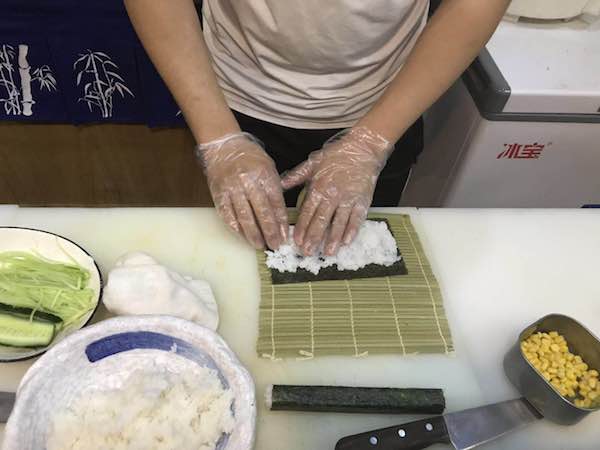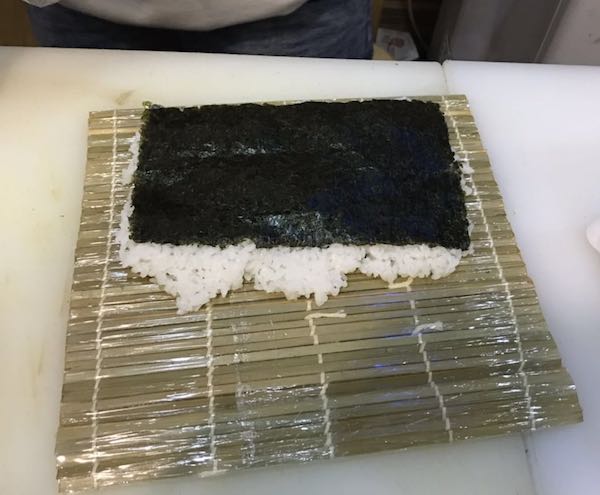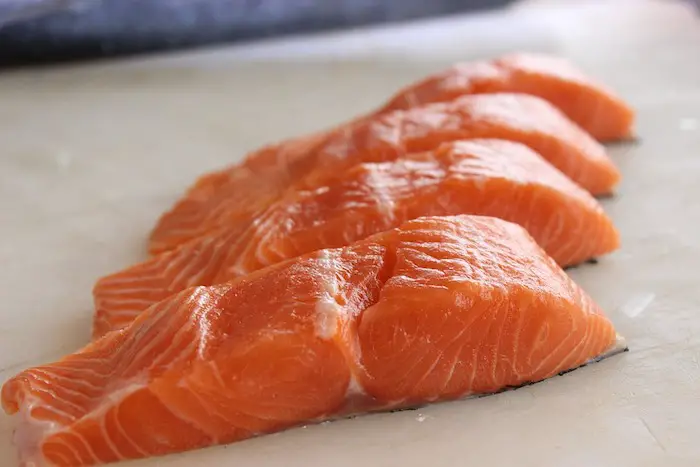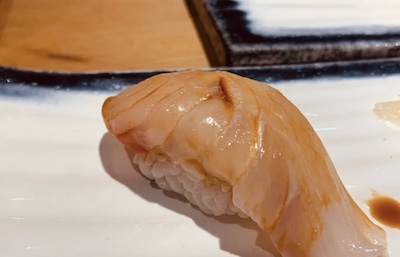We are reader supported. When you purchase through links on our site, we may earn an affiliate commission. Also, as an Amazon affiliate, we earn from qualifying purchases.

When I am at a new sushi restaurant for the first time, one of my ways of judging the food quality is ordering hamachi sushi. If the food smells ‘fishy’, I can tell that most of the other fish will not be fresh and I would rather stick to cooked meat or tempuras.
What is Hamachi sushi? This Japanese delicacy contains perfect slices of sushi-grade Hamachi, labeled as yellowtail in the West, over a bed of sushi rice. You can also find Himachi as toppings or fillings inside a sushi roll. The fish has a rich and buttery texture which makes it a favorite among sushi beginners.
Interestingly, Hamachi, labeled as Yellowtail in sushi restaurants in the West are often confused with tuna or yellowfin but they are neither of these two. Himachi is typically Japanese Amberjack, which is one of the three big yellowtails. It is considered as a luxury food in Japan and highly referred in sushi dishes.
Contents
Hamachi Nigiri Sushi Recipe
If a beginner asks me what is hamachi sushi or how to make one, I would recommend him to try this one first. This yellowtail fish has a creamy and buttery texture that most beginners fall in love with. However, some people may find a bit overwhelming at first.
What you will need:
- Japanese short-grain rice
- Sushi vinegar
- Salt
- Sugar
- Hamachi fillet
- Shiso leaves
Start by cooking short grain rice and when it perfectly cooked and cooled at room temperature, season with vinegar, salt, and sugar. I have created a step-by-step guide to help beginners cook sushi rice in a cooker or pot, check it out here.
Next prepare the fish. Make sure you buy only sushi grade Himachi from a trusted fishmonger or buy it online from reliable fish sellers such as Catalina Offshore Products. I prefer buying fish from them because they have a huge variety and the prices are reasonable too.
Take a sharp Japanese sushi knife (see my favorite one) and cut the Himachi fillets into thin strips in sashimi style. For this recipe, we will sear the fish with a blowtorch until it gets slightly charred to enhance the taste. You may also serve it raw to enjoy the rich and buttery texture.
Take a small ball of seasoned sushi rice in your palm and use your fingers to give it an oval shape. Lay the charred fish slice over the rice bed and blend them together with your hands. You may dab a little wasabi between the rice and fish to enhance the flavor.
Garnish with a shiso leaf on the top. Serve your delicious Hamachi nigirizushi with soy sauce, wasabi, and pickled ginger.
Hamachi Sushi Roll Recipe (Maki Roll)
If you are a fan of sushi rolls and like to dine out at sushi restaurants often, then you have probably come across the Negi Hamachi Sushi Roll. If you wish to introduce someone to raw fish, this sushi roll recipe can help you. The rich texture of Hamachi coupled with the incredible taste of sushi rice and other ingredients will make them crave for more!
What you will need:
- Cooked and seasoned sushi rice
- Sushi-grade hamachi or yellowtail fillets
- 2 green onions
- 1/2 Nori sheet
- Japanese cucumber
- Sriracha sauce
- Spicy Mayo
- Wasabi
First, you need to prepare sushi rice and for this, refer to the detailed instructions in this article that explains how to cook sushi rice in cooker and pot.
Slice sushi-grade hamachi fish using a sharp Japanese knife to have small slices that can be used as toppings to cover the outside of the sushi roll. You will need one slice for each piece, so prepare 6-8 slices for 6-8 bite-sized pieces.
Take the remaining hamachi, slice them lengthwise into strips and then cut further to make very small cube shapes. Avoid mincing the fish too much or else the texture will be lost.
Now, cut off the fresh and green part of the scallion (green onions). Chop them finely with a sharp knife and set aside.
Take a small bowl and mix together chopped scallions diced hamachi, ½ tbsp spicy mayo and 1 tsp of sriracha sauce. You may adjust the heat as per your liking.
Cut the cucumber lengthwise into thin strips and you are ready to roll. You may use a bamboo mat to roll sushi and if you don’t have one, here are some interesting ways to make sushi without a mat.
Place the bamboo mat or any other alternative of your choice on the kitchen counter and cover it with a plastic wrap. Now put half Nori sheet on the mat, rough side up.

Take a spoonful of sushi rice and spread it over the Nori, leaving some gap along the edges. Moisten your fingers and gently press the rice to the sheet without mashing them.
Now layer the diced hamachi mix in a straight line towards the middle of the sheet, arrange the chopped green onions beside the fish and then add the thin cucumber strips to balance the buttery texture of hamachi.
Lift the Nori sheet from your side and start rolling away from you. Apply gentle pressure as you roll to get a compact shape. Seal the edges with a few drops of water.
Take a sharp sushi knife, moisten the blades and cut the hamachi sushi roll into 6-8 pieces. Serve with pickled ginger and soy sauce.
Inside-out Hamachi Sushi Roll (Uramaki)

To make an inside-out roll, flip the Nori sheet after applying a layer of seasoned sushi rice to have rice facing downwards on the plastic wrap.
Add the fillings in a similar fashion as mentioned above and roll by lifting the bamboo mat from your end. When a compact cylinder is formed, remove the bamboo mat and arrange the sliced hamachi over the sushi roll.
Cover it with the plastic wrap, place the bamboo mat over the roll and press gently to ensure that the hamachi slices stay over the top.
Remove the bamboo mat and cut the sushi roll into slices with the plastic wrap on. Now, carefully remove the plastic wrap and serve the sushi pieces with wasabi and soy sauce.
Difference Between Hamachi And Yellowtail
Many people may use them interchangeably, but there’s a thin line of difference between Hamachi and Yellowtail that only the experts can tell.
Yellowtail, also known as Pacific Amberjacks are mostly found in the Indian and Pacific Oceans. They are identified by a yellow stripe mark along their body. They are often confused with yellowfin tuna due to a similarity in appearance but they differ widely in taste and texture.
Hamachi, also known as Japanese amberjack, is used to refer to the farm-raised yellowtail. They grow in a stress-free environment allowing them to gain high-fat content, resulting in a rich and buttery taste. As a result, hamachi is expensive and highly preferred as a raw ingredient.
According to experts, Hamachi is typically the upper part of young Japanese amberjack (about 6 pounds). The lower section is called wakana. When eaten raw, the meat of hamachi has a sweet flavor and fatty texture that melts inside the mouth.
Interesting Facts About Hamachi
If you are a non-Japanese wondering what is Hamachi sushi then let me tell you that this is a popular sushi ingredient known as Amberjack in Japan and Yellowtail in western countries. Here are some more interesting facts you would love to know about this delicious fish.
Hamachi belongs to a species of jackfish that is known by different names as it grows and matures. In Japanese, the fish in its mature stage is known as Kanpachi. When it weighs about 6 pounds, it is called Hamachi and when it is nearly 10 pounds, it is known as Buri. They all differ in flavor, texture, and taste.
The history of Japanese amberjack traces back to the Kagawa prefecture when the wild amberjacks were caught from the oceans. With time, the population of wild amberjacks decreased and they came close to becoming obsolete.
Around the 1940s, commercial production of farmed amberjack was started and there was a huge demand for this fish again. In Japan, Hamachi is mostly eaten as a rich sushi delicacy during the colder months.
As an extremely versatile fish, Hamachi is mostly served raw as sushi or sashimi. It is mostly served with soy sauce to bring out the delicate flavors. While raw hamachi is popularly used in sushi restaurants, you can find the poached or cooked version in Japanese homes. The cooked meat has a slightly firm texture.
Tips For Buying Sushi-Grade Hamachi

If you are planning to make Hamachi sushi tonight, you will first need to buy the sushi-grade fish from your trusted local fishmonger and other ingredients from an Asian grocery store. Here are a few buying tips to help you identify sushi-grade Hamachi :
The Japanese Amberjack has a light golden colored and succulent flesh. If you are buying fillets, look for a dark streak along the edges, which is the characteristic of a fish that thrives in open seas.
Make sure the fishmonger gives you sushi-grade fish only. When in doubt, ask questions such as when was the fish caught? What method was used for freezing? I have created an in-depth article to help you understand what is sushi-grade, signs to look for, and where to buy sushi-grade fish.
When it comes to the texture, Hamachi can be compared to tuna’s toro portion, which is buttery and smooth with a smoky flavor. In the Japanese Amberjack, the portions around the pectoral fins are often considered as the most delicious. They may be set aside for special customers at a sushi restaurant.
Ask your fishmonger to give you meat from the pectoral fins area as they are extremely rich in flavor without being overwhelmingly fatty. When you reach home, store the fish inside the fridge until it’s time to start preparing your sushi dinner.
5 Top Fish Alternatives For Hamachi
If you are unable to find sushi-grade Hamachi in the local fish market and you must have sushi for dinner, here are a few fatty alternatives you can try as a substitute.
#1. Bluefin Tuna
This is perhaps the most popular fish used for making sushi. Tuna is a large fish and just like hamachi, flesh from different portions of the fish have different texture and taste. Akami is the red meat from the top or back portion of the fish.
Chu-toro is the milky-white and marbled meat from the belly portion of the fish. O-toro comes from the fattiest part of the fish and it closely resembles hamachi’s buttery texture.
#2. Yellowfin tuna
This is a small sized tuna fish (up to 6 feet), mostly found in the tropical waters. They have a firm texture and mild flavor. Also known as ahi tuna fish in Hawaii, the color of Yellowfin tuna ranges from deep pink to reddish.
#3. Salmon

For most people who have no idea what to order at a sushi restaurant, salmon sushi would be a go-to choice. While this translucent orange to deep-red colored fish is full of flavors, I think it is slightly overrated in the world of sushi.
#4. Escolar
If you want a fish with a rich and buttery taste like hamachi, you may consider buying the escolar fish, also known as walu, butterfish, or super white tuna. The fish has an enormous amount of fatty oils that lend rich texture to it, but the downside is that human beings find it difficult to digest that fatty-content.
As a result, you must eat escolar fish in moderation. I have written an article on escolar fish, where you can find recipes, tips, and advice on how much is safe to eat.
#5. Mackerel
Although not as popular as tuna or salmon, the Japanese Mackerel is packed with umami flavors. It is extremely buttery and packed with fatty acids that give it a rich texture. It may be served raw, cooked or pickled to enhance the taste.
Related Questions
How much calories in hamachi sushi?
One serving or a piece of hamachi sushi roll contains about 51 calories, 8 grams carbs, 3 grams protein, and 0% fat.
Can you eat hamachi sushi when pregnant?
You must avoid hamachi (yellowtail) sushi while pregnant because the fish contains high levels of mercury. If you are craving for sushi, try the safer options like trout, shrimp, abalone, salmon, freshwater eel, tobiko, crab, uni, and so on.
See Also:
Kampyo Sushi ( Dried Shavings Of Calabash)
Is All Sushi Raw Or Cooked?
What Is Omakase Sushi?

